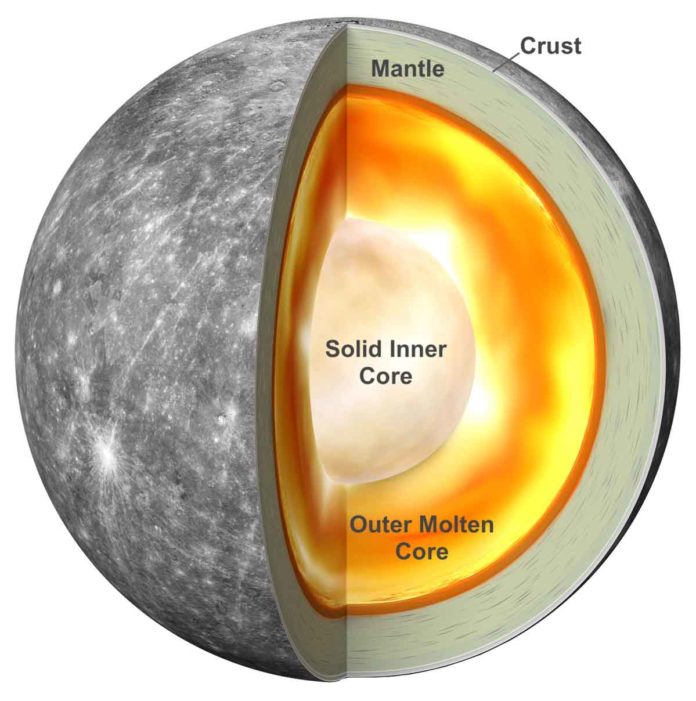In order to explore the interior of a planet, planetary scientists usually observe the planet spins and then measure how their probe orbits it. The same process is followed during NASA mission to Mercury.
Mercury is most closely related to the Earth’s Moon because the surface is heavily cratered and very old, but unlike the Moon, it has an internal metallic core, that is believed to be partially molten. Now, scientists in a new study have suggested that Mercury’s inner core is indeed solid and that it is nearly the same size as Earth’s inner core.
Sean Solomon, director of Columbia’s Lamont-Doherty Earth Observatory and principal investigator on the NASA mission that collected the critical data for this study said, “With this study, Mercury is now the second rocky planet — after Earth — for which we have evidence of a solid inner core. The new findings on the size of Mercury’s solid inner core will help scientists model the flow within its molten outer core to better understand how it gives rise to Mercury’s magnetic field.”
“The study also offers clues about how the solar system formed and how rocky planets change over time.”
Antonio Genova, an assistant professor at the Sapienza University of Rome who led the research while at the NASA Goddard Space Flight Center said, “Mercury’s interior has cooled more rapidly than our planet’s. Mercury may help us predict how Earth’s magnetic field will change as the core cools.”
The team used several observations from the MESSENGER mission to probe the interior of Mercury and find out what it’s made of. Scientists observed MESSENGER’s data on the planet’s spin and gravity field. Based on the data, they determined the gravitational anomalies and the location of its rotational pole, which allowed scientists to understand the orientation of the planet.
In 2007, radar observations made from Earth revealed small shifts in the spin of Mercury, called librations, that proved that the outer part of Mercury’s core must be molten metal. But observations of the spin rate alone were not sufficient to give a clear measurement of what the inner part of the core was like. Could there be a solid core lurking underneath, scientists wondered?
Gravity can help answer that question because a planet’s gravity field depends on its internal density structure. The scientists recorded how the MESSENGER spacecraft accelerated and decelerated under the influence of Mercury’s gravity field. During the last two years of the mission, MESSENGER’s closest approach drew progressively closer to Mercury’s surface. The final low-altitude passes before the spacecraft impacted the surface provided the highest-resolution data yet and allowed the team to make the most accurate measurements about the internal structure of Mercury yet taken.
Then they entered the MESSENGER data into a sophisticated computer program that allowed them to figure out what the interior density structure of Mercury must be like to match the way it spins and the way the spacecraft accelerated around it.
The results showed that for the best match, Mercury must have a large, solid inner core. They estimated that the solid, iron core is about 1,260 miles wide and makes up about half of the diameter of Mercury’s entire core (about 2,440 miles wide). In contrast, Earth’s solid core is about 1,500 miles across, compared with a diameter for the outer core of 4,200 miles.
Genova said, “Every new bit of information about our solar system helps us understand the larger universe.”
The study is described in Geophysical Research Letters.
